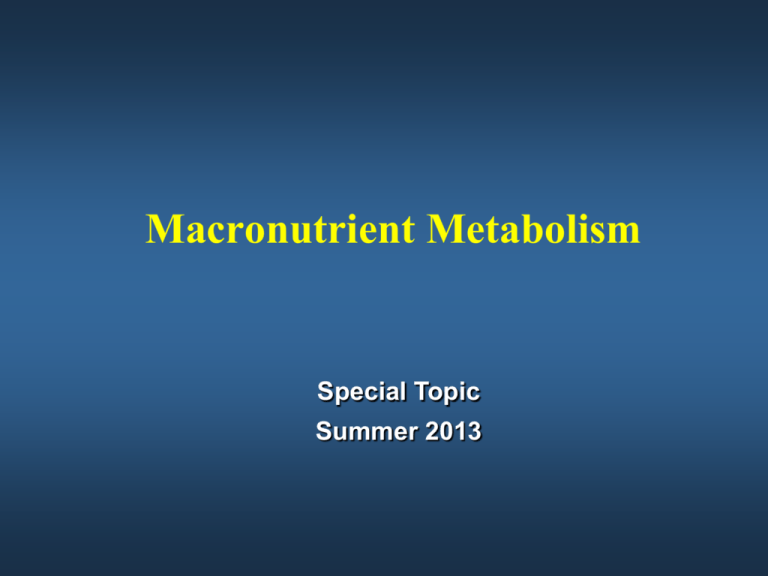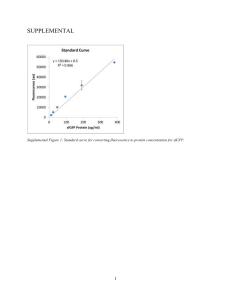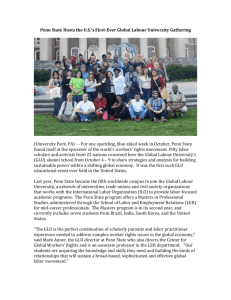Slides/AVS 504-Macronutrients
advertisement

Macronutrient Metabolism Special Topic Summer 2013 Carbohydrates Primary component of livestock feed Renewable resource as they are converted to CO2 and H2O. Primary carbohydrate in plants is glucose Comprise 70% of forage dry matter and 80% of concentrates Carbohydrates are a source of energy but there is no specific requirement for them Carbohydrates Carbon, hydrogen, oxygen Single-sugar units in ratio of 1:2:1 Exist as cyclic or ring structures Monosaccharides are sub-classified by number of carbons i.e., Tri-, tetr-, pent-, hex- Carbohydrates © 2007 Thomson - Wadsworth Carbohydrates 1.Sugars: Mono (# C) : C3, C4, C5, C6, C7 Pentoses: Ribose; Hexoses: Glu, Gal, Man, and Fru. Disaccharides: Sucrose, Lactose, Maltose Tri: Raffinose, Kestose Tetra: Stachyose 2. Non Sugars Polysaccharides Heteroglycans Homoglycans Pectic Substances Hemicellulose Arabinans Xylans Glucans Gums Chondroitin Starch, Dextrin, Glycogen, Cellulose Complex Carbohydrates • Glycolipids Glycoproteins Structural formulas of the pentoses ribose and deoxyribose and of the alcohol ribitol (reduction of ribose) Photosynthesis How does chemical structure of Monosaccharides relate to nutrition? Mono in the D configuration are more prevalent in the diet vs. L form. Mono are metabolized in the D configuration. Digestive enzymes are stereospecific: Amylase recognizes only α-1,4 linkage b/w glucose units In cellulose, glycoside bonds are β-1,4; amylase cannot hydrolyze them Disaccharides Formation of glycosidic bond © 2007 Thomson - Wadsworth © 2007 Thomson - Wadsworth Cellulose Starch Polysaccharides © 2007 Thomson - Wadsworth Polysaccharides Starches: combination of amylose & amylopectin Ratio is ~ 20:1 for α-1,4 linkage to α-1,6 linkage Cellulose: glu β-1,4 glu Not suitable for amylase Enzymatic hydrolysis of carbohydrates (note the presence of glucose) Primary Enzymes for Carbohydrates Food Source Enzyme Origin Product Starch, glycogen, dextrin Amylase (α1,4 Glu) Saliva & pancreas Maltose & Glucose Maltose Maltase (α1,4 Glu) Lactase (βGal) SI Glucose SI Glucose & galactose Sucrase (αGlu) SI Glucose & fructose Lactose Sucrose Digestion of Disaccharides cont. Disaccharidases Enzymes located on absorptive surface of small intestine cells Types: Sucrase hydrolzyes sucrose Lactase hydrolyzes lactose Maltase hydrolyzes maltose © 2007 Thomson - Wadsworth Digestion of Disaccharides © 2007 Thomson - Wadsworth Carbohydrate Absorption & Circulation Monosaccharides from digestion are absorbed by small intestine Transport occurs by: Active transport Facilitated diffusion Taken in blood to liver via hepatic portal vein Digestion & Absorption Luminal phase: on starches, none on disaccharides Brush border (microvilli): disaccharides by αglucosidase Entrocyte: uptake Brush border (microvilli) carbohydrate digestion Final hydrolysis of disaccharides to Monosaccharides is carried out by oligosaccaridases at the brush border of the small intestine. sucrose Glu Fru lactose Glu Gal Glu maltose Glu BB Brush border (microvilli) carbohydrate digestion Enzyme Specificity Natural substrate Product(s) Lactase (ββ-galactose galactosidase) Lactose Gal Glu Sucrase (αα-Glu galactosidase) α-(1, 2) bonds Sucrose Glu Fru Amylase α-(1, 4) Glu Amylose Glu Amylose (n-1) Maltase α-(1, 4) Glu Maltose Maltotriose Glu Isomaltase α-(1, 6) Glu α-limit dextrins Maltose isomaltose Glu Carbohydrate transport © 2007 Thomson - Wadsworth Transport of Glu from intestinal lumen to blood capillary cytoplasm Glu Glu 2 K+ GLUT2 K+ channel Na- K+ ATPase Glu K+ 2 Na+ K+ Na+ Lumen Dietary Glu 2 Na+ ATP K+ 3 Na+ ADP + Pi SGLUT1 What happens? Glu is co-transported with Na+ in the SI / kidney with a carrier protein SGLUT1. SGLUT1 binds Na+, stimulated to bind Glu on the lumen side, Na+ & Glu released into cell. Glu is extracted from SI / kidney & released into blood to go to the liver. Symport integral membrane protein SGLT1, simultaneously transports 2 substrates across membrane in the same direction The Na+ from diet & pancreatic secretion. [Na+] is greater in lumen of SI than in cytoplasm of epithelial cells. For transport of Na+ by symport, one Glu must be transported at the same time. Intra-cellular [Na+] is kept low by Na/K ATPase (an active transport protein). Na+/Glu symport occurs as long as Na/K ATPase is functioning Symport Glu transport into cell cytoplasm [Glu] cytoplasm [Glu] is greater than that in interstitial spaces Glu is transported down this concentration gradient via GLUT2 by facilitated diffusion Gal goes through the same process Transport of Fru from intestinal lumen to blood capillary Lumen cytoplasm Glu active Glu K+ K+ Na+ 2 K+ K+ Fru GLUT2 K+ channel Na- K+ ATPase Glu ATP 2 Na+ Dietary Glu/Gal 2 Na+ ADP + Pi 3 Fru Na+ Fru Fru facilitated SGLUT1 GLUT5 A transporter: Hexose Transport Transport hexoses down a concentration gradients (GLUT1, GLUT2, GLUT3, GLUT4, GLUT5) Transport hexoses against a concentration gradient (SGLUT1) Hexose Transport GLUT1, 3, and 4: high affinity for Glu (Km=2-5 mM): functioning at maximal rate under physiological condition ([Glu] ~5 mM). GLUT2: low affinity for Glu (Km=15 mM): allows it to change transport rate relative to [Glu] after consuming a carbohydrate-rich meal. GLUT5: high affinity for Fru. Glucose/Galactose Malabsorption (GGM) A rare metabolic disorder; caused by defect in Glu/Gal transport across intestinal lining. An autosomal recessive disorder; affected person inherits two defective copies of SGLUT1 gene (on chromosome 22). May be related to familial intermarriage. Sever diarrhea & dehydration in 1st d of life; lethal if not treated by completely removing dietary lactose, sucrose, glucose and galactose. Release of Insulin & Glucagon from the Pancreas © 2007 Thomson - Wadsworth Glycemic response Hormonal Regulation of Blood Glucose © 2007 Thomson - Wadsworth © 2007 Thomson - Wadsworth Hormonal Regulation of Blood Glucose © 2007 Thomson - Wadsworth Theories of diabetes mellitus etiology Patho-physiology of diabetic acidosis Metabolic Pathways Fig. 8-1, p. 270 Fig. 8-2, p. 271 Fig. 8-3, p. 273 Major Pathways of Carbohydrate metabolism The Role of Coenzymes in Energy Metabolism Fig. 8-4, p. 275 Anabolic and Catabolic Pathways Are Regulated by Hormones Fig. 8-5, p. 276 Metabolism of carbohydrates Glycolysis Citric acid cycle No oxygen required-anaerobic In cytoplasm oxygen required-aerobic In mitochondria Electron transport oxygen required-aerobic In mitochondria Generates energy (ATP) Energy from macronutrients Number of mitochondria Cardiac muscle cell (high concentration of mitochondria) Liver cells (same as above) Skeletal muscle (less than cardiac cells) Red blood cells (no mitochondria) Completely dependent on glycolysis (Glu lactate + H+) Glu Glu Glycogen Glu-6-P Glu-6-P ATP ATP Glu-6-P ATP 2 pyruvate 2 pyruvate 2 Acetyl Co-A 2 pyruvate 2 Acetyl Co-A ATP ATP 4 CO2 2 lactate TCA 4 CO2 TCA Red blood cells Brain tissue cells Skeletal or cardiac tissue cells Glu Glu Glycogen Glu-6-P ATP 2 pyruvate 2 acetyl Co-A Glu Glu-6-P ATP 2 pyruvate 2 acetyl Co-A ATP FAT Adipose tissue cells TCA FAT Hepatocytes Glycolysis Going into TCA cycle..!?! Hexokinase reaction The HK reaction converts nonionic Glu into an anion trapped in the cell (no transporter for P-Glu Inert Glu becomes activated into a labile form capable of being further metabolized Four types are known (HK I – HK IV) with HK IV known as glucokinase Glucokinase in hepatocyte has a very high Km; enzyme is saturated only when there is very high concentration of Glu. Reciprocal regulation of glycolysis and gluconeogenesis Regulated by hormones & energy level of the cell. Hormonal regulation: High Fru-2,6 bis P favors glycolysis High Fru-2,6 bis P inhibits gluconeogenesis Energy level High AMP & ADP, and low ATP & citrate favors glycolysis These conditions inhibit gluconeogenesis Glycolysis=catabolic Gluconeogenesis=anabolic Substrate (futile) Cycles Glucose Glycolysis ATP citrate H+ Fru-6-P negative negative Phospho Fru kinase F-2,6 BP Gluconeogenesis AMP F-1,6B Phospha ase positive citrate Fru-1,6 bis P positive F-2,6 AMP BP Phosphoenelpyruvate F-2,6 BP PEP carboxy kinase positive ADP Oxaloacetate Pyruvate kinase ATP negative Pyruvate carboxylase alanine Pyruvate negative ADP negative positive Acetyl Co A Hormonal control of glycolysis & gluconeogenesis by Fru 2,6 Bisphosphate (F-2,6 P2) The enzyme is structurally related to F-1,6 BP Not an intermediate Is an “ALOSTERIC” regulator F-2,6 P2 activates PFK & glycolysis F-2,6 P2 inhibits FBPase & gluconoegenesis in glucagon (during starvation): & gluconeogenesis F-2,6 P2 : in glucagon (after meal): F-2,6 P2 : glycolysis glycolysis F-2,6 P2 acts as an intracellular signal indicating “glucose abundant” Fru 2,6 Bisphosphate (F-2,6 P2): Central regulator Activates PFK Inhibits F-1,6 BisPase It is formed by PF2Kinase & hydrolyzed by F-2,6 BisPase “Bifunctional enzyme” High levels of Fru-6-P: PF2Kinase: F-2,6 P2 Glycolysis Gluconeogenesis Fig. 8-18, p. 293 Regulation: enzymes functioning Functionally, zone I hepatocytes are specialized for oxidative liver functions such as gluconeogenesis, β-oxidation of fatty acids and cholesterol synthesis, while zone III cells are more important for glycolysis, lipogenesis. The functional unit is the hepatic acinus (terminal acinus), each centered on the line connecting two portal triads and extends outwards to the two adjacent central veins. The periportal zone I is nearest to the entering vascular supply and receives the most oxygenated blood. Conversely, the centrilobular zone III has the poorest oxygenation. Central vein http://wapedia.mobi/en/Hepatic_lobule Hepatic artery Bile duct portal vein http://www.siumed.edu/~dking2/erg/liver.htm Portal Triad Portal vein provides nutrient-rich blood (70%) Hepatic artery provides Oxygen-rich blood (30%) Metabolic pathways are compartmentalized in liver acinus Glycolysis primarily in pericentral (perivenous) Hepatocytes (zone 3) Low O2 pressure GLUT 1 (high Km) present; low affinity for Glu GLUT 2 in all Hepatocytes Gluconeogenesis primarily in periportal Hepatocytes (zone 1) Glu is not taken up here Zonation decreases with fasting: more Glu needs to be produced and released “All cells become active in gluconeogenesis” The Cori Cycle The Krebs cycle The Krebs cycle The Pyruvate dehydrogenase reaction Abr Enzyme Prosthetic group E1 Pyruvate dehydrogenase thiamin pyrohosphate;TPP in periphery of the complex E2 dihydrolipoamide acetyltransferase Lipoamide monomer, many copies interior E3 dihydrolipoamide dehydrogenase FAD dimer, fewer copies in periphery Schematic representation of the reactions conducted by E1, E2 and E3 of pyruvate dehydrogenase complex E1 requires thiamin pyrophosphate (TPP) and Mg++ ion cofactors for decarboxylation of pyruvate followed by the reductive acetylation of the lipoic acid covalently bound to the E2 enzyme of Pyruvte DH. This enzymatic function is completed in two reactions with formation of reaction intermediate, 2-ahydroxyethylidene-TPP How does it work? E1 catalyzes the non-reversible removal of CO2 from pyruvate; E2 forms acetyl-CoA, E3 reduces NAD+ to NADH, and E3-binding protein provides E3 with binding sites to the core of the complex. Two additional enzymes associated with the complex: a specific kinase which is capable of phosphorylating E1 at serine residues and a loosely-associated specific phosphatase which reverses the phosphorylation. The activity of the complex may be regulated in vivo by the availability of substrates pyruvate and lipoamide themselves, as well as by the relative concentrations of NAD/NADH, CoA/acetyl-CoA, ADP/ATP, and the proportion of E1 in its active dephosphorylated state. Regulation of Pyruvate Dehydrogenase Complex Regulated by the products of the rxn they catalyze E1 is negatively regulated by [GTP] & positively by [AMP] E2 is negatively regulated by [acetyl Co A] E3 negatively regulated by [NADH]/[NAD ] E1-P is inactive: [acetyl Co A]: increase in E1-P formation Pyruvate decrease in E1-P formation Regulation of Pyruvate Dehydrogenase Complex P ADP NADH PDC H 2O Acetyl Co A Inactive ATP + PDC kinase PDC phosphatase - + NAD Pyruvate Mg+ CoASH Ca+ ADP Ca+ ATP Pyruvate + Co ASH +NAD+ PDC Active P Acetyl Co A + NADH + CO2 ATP Formation from Glucose Catabolism Fig. 8-13, p. 285 Direct formation of OXL from pyruvate Mitochondrial compartments Outer membrane is porous. Inner membrane is the major permeability barrier. It has foldings (cristae) containing respiratory chain & ATP synthase (electron transport & oxidative phosphorylation). Matrix contains PDC, enzymes for TCA cycle & FA oxidation Oxidative Phosphorylation and the Electron Transport Chain Oxidative Phosphorylation and the Electron Transport Chain FMN in complex I is the 1st e- acceptor. Co-Q (complex III) not a transmembrane protein. Complex III and Cyt C work together. In complexes I, III & IV, enough energy to pump H+ out. Complex V: F0 opening for H+ F1: coupling http://www.google.com/imgres?imgurl=http://upload.wikimedia.org/wikipedia/commons/thumb/8/89/Mitochondrial_electron_transport_chain%E2%80%94Etc4.svg/400pxMitochondrial_electron_transport_chain%E2%80%94Etc4.svg.png&imgrefurl=http://en.wikipedia.org/wiki/Oxidative_phosphorylation&usg=__SnUjBt4yoOKNiJfKna4WVg0PAhw=&h=362&w=400&sz=108&hl=en&s tart=0&zoom=1&tbnid=O9H_23gAlWEoaM:&tbnh=137&tbnw=151&ei=zy0jTuixKKXliAKHivW3Aw&prev=/search%3Fq%3Dpathway%2Bof%2Belectron%2Btransport%2Band%2Boxidative%2Bphosphorylation%26hl %3Den%26biw%3D1280%26bih%3D923%26gbv%3D2%26tbm%3Disch&itbs=1&iact=hc&vpx=185&vpy=83&dur=659&hovh=214&hovw=236&tx=167&ty=124&page=1&ndsp=28&ved=1t:429,r:0,s:0&biw=1280&bih=9 23 F0: pore in inner mitochondrial membrane; opening for H+ to move F1β is ATP synthase http://www.google.com/imgres?imgurl=http://www.biologie.uni-hamburg.de/b-online/fo19/map03110.gif&imgrefurl=http://www.biologie.uni-hamburg.de/bonline/e19/19d.htm&usg=__RwnNZhe9YkPSxsC4D2BkDLPeo0=&h=444&w=483&sz=13&hl=en&start=0&zoom=1&tbnid=rgnKr6IY05kUJM:&tbnh=135&tbnw=147&ei=6TAjTtifAqvWiAL61KnEAw&prev=/search%3Fq%3DATP%2 Bsynthase%26hl%3Den%26biw%3D1280%26bih%3D923%26gbv%3D2%26tbm%3Disch&itbs=1&iact=hc&vpx=334&vpy=271&dur=2055&hovh=215&hovw=234&tx=133&ty=128 &page=1&ndsp=31&ved=1t:429,r:7,s:0&biw=1280&bih=923 Chemiosmotic Coupling Complexes I, III, IV all “pump” H+ into space b/w the inner and outer mitochondrial membrane. Creating a “proton gradient” across the inner membrane. While protons pass through complex V, osmotic energy of the gradient is converted to chemical energy (ATP). Chemiosmotic Coupling: the use of transmembrane proton gradient (exergonic reduction rxn b/w complex I and IV, to drive energy-requiring rxn of ATP synthesis. Glycogenesis Glycogenin Glycogenolysis Release of Insulin & Glucagon from the Pancreas © 2007 Thomson - Wadsworth © 2007 Thomson - Wadsworth Regulation of glycogen phosphorylase Hexomonophosphate shunt Amino acids Transamination and Deamination Fig. 8-14, p. 287 Lipolysis Fig. 8-15, p. 288 Ketogenesis Energy Balance + Energy Balance (Mcal / d) 0 TIME Energy Metabolism During Negative Energy Balance G-6-Pase Glucose-6-P Glycolysis Glucose Gluconeogenesis Pyruvate Fatty Acids (NEFA) Acetyl-CoA Ketones Oxaloacetate Citrate Krebs Cycle Liver 2 CO2 12 ATP Hrycyna, 2004 Ketosis • Increased plasma [AcAc, Ac, BHBA] results in ketosis • Incomplete FA oxidation & Severe NEB results in [blood ketones] Fatty liver Symptoms Cause Greater than 20% fat in liver cells Treatment Liver failure dull, depressed, stop eating labored breathing High forage diet and watch for other problems Prevention Good pre-fresh diet, no fat cows Insulin-independent & insulin-dependent pathways of glucose metabolism The microsomal ethanol oxidizing system (mixed function oxidases) Overview of Energy Metabolism Fig. 8-20, p. 296 Interconversion of macronutrients Disposition of dietary glucose, AA, and fat in fed state Primary post-absorption flow of substrates Flow of substrates during fasting & starvation Fig. 8-21, p. 297 Dietary Fiber Group of plant polysaccharides that are not digested or absorbed in the human small intestine © 2007 Thomson - Wadsworth Carbohydrates digestion in the rumen Carbohydrates digestion in the rumen Acetate Pyruvate + Pi + ADP Acetate + ATP + H2 + CO2 Cellulolytic bacteria Energy source for rumen epithelium and muscle Not utilized by liver Acetate utilization Important as a precursor to de novo fatty acid synthesis Adipose Lactating mammary gland Oxidized via TCA Activated to acetyl CoA Used by skeletal muscle, kidneys, and heart for energy Net gain of 10 ATP per mole of acetate Acetate utilization Dependent upon Energy balance Generates CO2 and H2O (i.e., ATP) when in low energy balance Used for fatty acid synthesis when animal is in high energy balance Arterial concentration Tissue uptake is directly related to rate of rumen fermentation [blood concentration] Propionate Pyruvate + CoA + 4H+ Propionate + H2O Amylolytic bacteria Utilized by rumen epithelium Converted to lactate and pyruvate Important as a precursor for gluconeogenesis Hepatic propionate metabolism Glucose OAA TCA Cycle Succinyl CoA Coenzyme B12 Methylmalonyl CoA ADP + Pi Biotin, Mg++ ATP Propionyl CoA AMP + 2 Pi ATP CoA Propionate Butyrate Pyruvate + CoA Acetyl-CoA + H2 + CO2 2 Acetyl-CoA + 4H+ Butyrate + H2O + CoA Metabolized by rumen epithelium to ketone bodies (acetoacetate, hydroxybutyrate) Later metabolized in the liver Net ATP production is 25 per mole Ruminal VFA absorption Acetate Rumen Rumen Portal lumen wall vein 70 50 20 Propionate 20 10 10 Butyrate 10 1 9 Values are relative flux rates Hepatic metabolism of VFA Rumen Portal Liver vein 70 50 Propionate 20 10 Acetate Peripheral blood Acetate Glucose Glucose CO2 Butyrate 10 1 4 3-OH butyrate 3-hydroxy Butyrate (BHBA)





